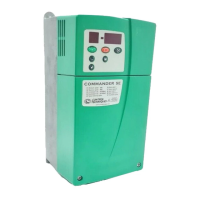Commander SE Advanced User Guide 47
Issue Number: 4
This parameter selects the voltage control mode used. This falls into two categories: vector mode (0 and 1) and fixed boost
(2). The voltage characteristics for these two modes have been covered in the description of 5.09.
The difference between the two versions of vector mode is that mode 0 measures the stator resistance and voltage offset
every time the drive is started to compensate for any change in temperature in the machine, while mode 1 assumes that the
values have been setup by an autotune.
Mode (0):
The stator resistance (5.17 or 21.12) and the voltage offset (5.23 or 21.13) are measured each time the drive is started. This
test can only be carried out with a stationary machine where the flux has decayed to zero. Therefore this mode should only
be used if the machine is guaranteed to be stationary each time the drive is enabled. To prevent the test from being carried
out before the flux has decayed there is a period of 2 seconds after the drive has been in the ready state during which the test
is not carried out if the drive is re-started. In this case, previously measured values are used.
Mode (1):
The stator resistance and voltage offset are not measured. This version should be used if the above version cannot be used.
The resistance of the machine and cabling can be measured, but will not include ‘resistance’ effects within the drive. The
voltage offset (see 5.23) is a function of the drive and cannot be measured by the user. Therefore the best method to obtain
this parameter is to run the autotune during commissioning.
Mode (2):
Fixed boost mode. Neither the stator resistance or the voltage offset are used, instead the boost voltage is applied as defined
by 5.15 and 5.09.
Fixed boost mode should be used for multiple motor applications.
Mode (3):
The stator resistance and voltage offset are measured the first time the drive is enabled. After test, even if it fails, the mode is
changed to 1 and the stator resistance and voltage offset measurements are used in the vector calculations.
After a default operation has been performed the stator resistance and voltage offset are measured once, the first
time the drive is enabled. If the test passes, the mode is changed to 1 and the stator resistance and voltage offset
measurements are used in the vector calculations. If the test fails due to not enough current being drawn i.e. no
motor connected, the mode will remain at 3. See parameter 5.12 - Autotune.
The boost level for the fixed boost characteristic is defined by this parameter.
This parameter stores the stator resistance of the machine for vector mode operation. Although it is designated as read/write,
it is read only if vector mode 0 is selected with 5.14. If the drive cannot achieve the necessary current levels to measure the
stator resistance in mode 0 or during an autotune (e.g. there is no motor connected to the drive), an rS trip will occur and the
value in 5.17 remains unchanged. If the necessary current level can be achieved, but the calculated resistance exceeds the
maximum values for the particular drive size, an rS trip will occur and 5.17 will contain the maximum allowed value. The
maximum value can be calculated from the following formula:
Rs
max
= V
DC full_scale
/ (I
full_scale
x 2)
where:
V
DC full_scale
= Maximum measurable DC Bus voltage (420V or 830V)
I
full_scale
= Drive rated current x √2 x 2
When an autotune is carried out by the drive, the calculated stator resistance is automatically saved.
5.14 Voltage mode selector
Ú
0 ~ 3
Ö
3 RW Uni
5.15 Low frequency voltage boost
Ú
0 ~ 25.0
Ö
3.0 % RW Uni
5.16
Unused parameter
5.17
Stator resistance
Ú
0 ~ 99.99
Ö
0.0 Ω RW Uni
NOTE
NOTE

